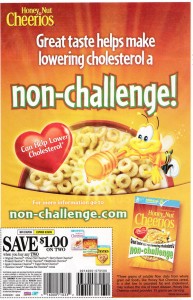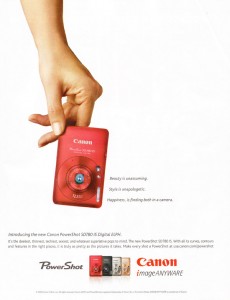words got in the way
Advertising legend David Ogilvy once said, “Our business is infested with idiots who try to impress by using pretentious jargon.” Those are pretty harsh words and I’m not sure I agree (entirely), but sometimes I see ads that seem to have been written by folks who are trying to impress vs. persuade or sell. Their words, it seems, have gotten in the way of their points.
Here are few recent examples:

I had to read the headline of this FSI three times before I understood what it meant. I don’t know if it’s the awkward sentence structure or the use of a non-word (“non-challenge”), but the point of the ad — that Honey Nut Cheerios helps lower cholesterol — got lost in my confusion. It seems the writer of the line sacrificed clarity for cleverness.

I’m guessing the objective of this ad is to highlight the cool style and size of the new Canon PowerShot SD780 IS Digital ELPH (say that 3 times fast). And the image in the ad does indeed make this point compellingly. So, then, why is the headline needed? It doesn’t add anything — in fact, it doesn’t seem to be saying anything at all. Perhaps if the headline pointed to the combination of the camera’s style and power (or functionality or quality), there might have been a reason to include it — but as is, the words seem to get in the way of the striking visual.

This last example comes from Pearl Izumi. I point this out because unless you’re very astute or you’re familiar with the logo, you probably might not figure that out — which brings me to why this is another example of copywriting gone bad. If you take the time to read this entire ad, you’ll see the headline is talking about sperm and the copy is calling on readers to procreate in order to populate the world with more real runners (vs. ones in quotation marks.) Regardless of whether you find the ad humorous or offensive, I think you will agree that it says nothing about the product or brand.
Regular readers of mine know that I don’t often rant — and I intend this post as no exception. I’m not highlighting these examples just to point out how bad they are. Instead I hope to encourage people who create ads to consider how words can add or detract to the point they’re trying to make — and perhaps to focus first on the advertising objective and then on the creative way to fulfill it.
I think this is what Ogilvy meant in another of his famous quotes, “If it doesn’t sell, it isn’t creative.”
related posts: